Simulation Effect of Water and Nitrogen Transport under Wide Ridge and Furrow Irrigation in Winter Wheat Using HYDRUS-2D
Abstract
:1. Introduction
2. Materials and Methods
2.1. Soil Conditions and Experiment Design
2.1.1. Overview of the Study Area and Soil Characteristics
2.1.2. Experiment Design
2.2. Determination Items and Methods
2.2.1. Soil Moisture Measurement
2.2.2. Determination of Soil Nitrogen Content
2.2.3. Fertilizer Agronomic Efficiency, Fertilizer Physiological Efficiency, Fertilizer Utilization Efficiency, and Partial Factor Productivity of Fertilizer
2.3. Mathematical Model
2.3.1. Water Movement Equation
2.3.2. Solute Transport Equation
2.3.3. Root Water Absorption Equation and Root Growth
2.3.4. Crop Transpiration Rate
2.4. Boundary Conditions
2.5. Parameter Inversion and Model Calibration
3. Results
3.1. Model Verification
3.2. Model of Soil Nitrogen Balance
4. Discussion
4.1. Inversion of Water Transport Parameters and Physicochemical Solute Parameters
4.2. Nitrogen Balance
5. Conclusions
Author Contributions
Funding
Data Availability Statement
Acknowledgments
Conflicts of Interest
References
- Ines, A.V.M.; Gupta, A.D.; Loof, R. Application of GIS and crop growth models in estimating water productivity. Agric. Water Manag. 2002, 54, 205–225. [Google Scholar] [CrossRef]
- Xu, B.W.; Niu, Y.R.; Zhang, Y.N.; Chen, Z.F.; Zhang, L. China’s agricultural non-point source pollution and green growth: Interaction and spatial spillover. Environ. Sci. Pollut. Res. 2022, 29, 60278–60288. [Google Scholar] [CrossRef]
- Sebilo, M.; Mayer, B.; Nicolardot, B.; Mariotti, A. Long-term fate of nitrate fertilizer in agricultural soils. Proc. Natl. Acad. Sci. USA 2013, 110, 18185–18189. [Google Scholar] [CrossRef] [PubMed]
- Bai, J.; Ye, X.; Zhi, Y.; Gao, H.; Huang, L.; Xiao, R.; Shao, H. Nitrate–nitrogen transport in horizontal soil columns of the Yellow River Delta wetland, China. CLEAN Soil Air Water. 2012, 40, 1106–1110. [Google Scholar] [CrossRef]
- Fronczyk, J.; Sieczka, A.; Lech, M.; Radziemska, M.; Lechowicz, Z. Transport of nitrogen compounds through subsoils in agricultural areas: Column tests. Pol. J. Environ. Stud. 2016, 25, 1505–1514. [Google Scholar] [CrossRef]
- Pan, W.Y.; Huang, Q.Z.; Xu, Z.H.; Pang, G.B. Experimental investigation and simulation of nitrogen transport in a subsurface infiltration system under saturated and unsaturated conditions. J. Contam. Hydrol. 2020, 231, 103621. [Google Scholar] [CrossRef]
- Ali, A.; Bennett, J.M.; Biggs, A.A.J.; Marchuk, A.; Ghahramani, A. Assessing the hydraulic reduction performance of HYDRUS-1D for application of alkaline irrigation in variably-saturated soils: Validation of pH driven hydraulic reduction scaling factors. Agric. Water Manag. 2021, 256, 107101. [Google Scholar] [CrossRef]
- Mekala, C.; Nambi, I.M. Understanding the hydrologic control of N cycle: Effect of water filled pore space on heterotrophic nitrification, denitrification and dissimilatory nitrate reduction to ammonium mechanisms in unsaturated soils. J. Contam. Hydrol. 2017, 202, 11–22. [Google Scholar]
- Martin del Campo, M.A.; Esteller, M.V.; Morell, I.; Expósito, J.L.; Bandenay, G.L.; Morales-Casique, E. Effect of organic matter and hydrogel application on nitrate leaching in a turfgrass crop: A simulation study using Hydrus. J. Soils Sediments 2021, 21, 1190–1205. [Google Scholar] [CrossRef]
- Han, H.; Gao, R.; Cui, Y.; Gu, S. Transport and transformation of water and nitrogen under different irrigation modes and urea application regimes in paddy fields. Agric. Water Manag. 2021, 255, 107024. [Google Scholar] [CrossRef]
- Mehrabi, F.; Sepaskhah, A.R. Soil drainage water and nutrient leaching in winter wheat field lysimeters under different management practices. Int. J. Plant Prod. 2021, 15, 13–28. [Google Scholar] [CrossRef]
- Li, M.Y.; Hu, T.T.; Cui, X.L.; Luo, L.L.; Lu, J.S. Comprehensive effects of irrigation water and nitrogen levels for controlled release fertilizer with different release periods on winter wheat yield. Trans. Chin. Soc. Agric. Eng. 2020, 36, 153–161. [Google Scholar]
- Gu, S.W.; Gao, J.M.; Deng, Z.; Lv, M.C.; Liu, J.Y.; Zong, J.; Qin, J.T.; Fan, X.C. Effects of border irrigation and fertilization timing on soil nitrate nitrogen distribution and winter wheat yield. Trans. Chin. Soc. Agric. Eng. 2020, 36, 134–142. [Google Scholar]
- Li, H.R.; Hao, W.P.; Mei, X.R.; Guo, R. Effect of different irrigation and fertilization managements on N2O emissions and yeild in summer maize-winter wheat field. Trans. Chin. Soc. Agric. Eng. 2018, 34, 103–112. [Google Scholar]
- Karandish, F.; Šimůnek, J. A comparison of the HYDRUS (2D/3D) and SALTMED models to investigate the influence of various water-saving irrigation strategies on the maize water footprint. Agric. Water Manag. 2019, 213, 809–820. [Google Scholar] [CrossRef]
- Sharmiladevi, R.; Ravikumar, V. Simulation of nitrogen fertigation schedule for drip irrigated paddy. Agric. Water Manag. 2021, 252, 106841. [Google Scholar] [CrossRef]
- Jia, Y.; Gao, W.; Sun, X.; Feng, Y. Simulation of Soil Water and Salt Balance in Three Water-Saving Irrigation Technologies with HYDRUS-2D. Agronomy 2023, 13, 164. [Google Scholar] [CrossRef]
- Clément, C.C.; Cambouris, A.N.; Ziadi, N.; Zebarth, B.J.; Karam, A. Potato Yield Response and Seasonal Nitrate Leaching as Influenced by Nitrogen Management. Agronomy 2021, 11, 2055. [Google Scholar] [CrossRef]
- Wang, X.; Huang, G.; Yang, J.; Huang, Q.; Liu, H.; Yu, L. An assessment of irrigation practices: Sprinkler irrigation of winter wheat in the North China plain. Agric. Water Manag. 2015, 159, 197–208. [Google Scholar] [CrossRef]
- Wang, S.S. Research on the Specification Parameters and Crop Water Demand Characteristics of Integrated Ridge Farming and Furrow Irrigation. Ph.D. Thesis, Xi’an University of Technology, Xi’an, China, 2013. [Google Scholar]
- Noor, H.; Wang, Q.; Sun, M.; Fida, N. Effects of sowing methods and nitrogen rates on photosynthetic characteristics, yield and quality of winter wheat. Photosynthetica 2021, 59, 277–285. [Google Scholar] [CrossRef]
- Zhang, Y.; Wang, J.; Gong, S.; Xu, D.; Sui, J. Nitrogen fertigation effect on photosynthesis, grain yield and water use efficiency of winter wheat. Agric. Water Manag. 2017, 179, 277–287. [Google Scholar] [CrossRef]
- Richards, L.A. Capillary Conduction of liquids through porous mediums. Physics 1931, 1, 318–333. [Google Scholar] [CrossRef]
- Simunek, J.; Sejna, M.; Van Genuchten, M.T. HYDRUS-2D Simulating Water Flow, Heat, and Solute Transport in Two-Dimensional Variably Saturated Media; International Ground Water Modeling Center: Riverside, CA, USA, 1999. [Google Scholar]
- Hanson, B.R.; Šimůnek, J.; Hopmans, J.W. Evaluation of urea–ammonium–nitrate fertigation with drip irrigation using numerical modeling. Agric. Water Manag. 2006, 86, 102–113. [Google Scholar] [CrossRef]
- Biao, B.; Qian, Y.K.; Ai, X.F.; Zhao, T.N. Sensitivity analysis of VG model parameters under rainfall infiltration conditions based on HYDRUS-1D simulation. J. Yangtze River Acad. Sci. 2021, 38, 36–41. [Google Scholar]
- Li, B. Experiment and Simulation Study on Soil Water Movement and Nitrogen Transport in Wide Ridge and Furrow Irrigation. Master’s Thesis, North China University of Water Resources and Electric Power, Zhengzhou, China, 2019. [Google Scholar]
- Phogat, V.; Mahadevan, M.; Skewes, M.; Cox, J.W. Modelling soil water and salt dynamics under pulsed and continuous surface drip irrigation of almond and implications of system design. Irrig. Sci. 2012, 30, 315–333. [Google Scholar] [CrossRef]
- Siyal, A.A.; Bristow, K.L.; Šimůnek, J. Minimizing nitrogen leaching from furrow irrigation through novel fertilizer placement and soil surface management strategies. Agric. Water Manag. 2012, 115, 242–251. [Google Scholar] [CrossRef]
- Beven, K.J.; Henderson, D.E.; Reeves, A.D. Dispersion parameters for undisturbed partially saturated soil. J. Hydrol. 1993, 43, 9–43. [Google Scholar] [CrossRef]
- Feng, Z.Z.; Shi, H.B.; Miao, Q.F.; Sun, W.; Liu, M.H.; Dai, L.P. Analysis of water use of cultivated land in typical sand layers in Hetao Irrigation Area based on HYDRUS-1D model. Trans. Chin. Soc. Agric. Eng. 2021, 37, 90–99. [Google Scholar]
- Sun, X.Y.; Tong, J.X.; Liu, C.; Ma, Y.B. Using HYDRUS-2D model to simulate the water flow and nitrogen transport in a paddy field with traditional flooded irrigation. Environ. Sci. Pollut. Res. 2022, 29, 32894–32912. [Google Scholar] [CrossRef]
- Nie, S.Y. Simulation on Water and Nitrogen Transport of Saline-alkali Vadose Zone in Western of Jilin Province. Ph.D. Thesis, Jilin University, Changchun, China, 2018. [Google Scholar]
- Feng, C. Research of Soil Hydraulic Properties and Nitrogen Conversion Parameters under the Couple of Water-Temperature-Nitrogen. Master’s Thesis, Taiyuan University of Technology, Taiyuan, China, 2017. [Google Scholar]
- Wu, X.B.; Bai, M.J.; Li, Y.N.; Du, T.S.; Zhang, S.H.; Shi, Y. Effects of water and fertilizer coupling on root growth and soil water and nitrogen distribution of cabbage under drip irrigation under film. Trans. Chin. Soc. Agric. Eng. 2019, 35, 110–119. [Google Scholar]
- Si, Z.; Zain, M.; Mehmood, F.; Wang, G.; Gao, Y.; Duan, A. Effects of nitrogen application rate and irrigation regime on growth, yield, and water-nitrogen use efficiency of drip-irrigated winter wheat in the North China Plain. Agric. Water Manag. 2020, 231, 106002. [Google Scholar] [CrossRef]
- Wang, J.Y. Effects of Tillage and Fertilization on Soil Nitrogen Leaching and Root Growth in Rice-wheat Rotation Area. Master’s Thesis, Chinese Academy of Agricultural Sciences, Beijing, China, 2021. [Google Scholar]
- Loboda, T. Gas exchange and growth of triticale seedlings under different nitrogen supply and water stress. J. Plant Nutr. 2010, 33, 371–380. [Google Scholar] [CrossRef]
- Li, S.H. Effects of Different Moisture on Nitrogen Transformation, Functional Genes and Microorganisms in Black Soil. Master’s Thesis, Dalian Jiaotong University, Dalian, China, 2019. [Google Scholar]
- Tan, X.; Shao, D.; Liu, H.; Sun, C. Experiment and simulation of water and nitrogen balance in paddy fields under water-saving irrigation and controlled drainage conditions. Trans. Chin. Soc. Agric. Eng. 2011, 27, 193–198. [Google Scholar]
- Chen, L. Study on the Transport and Transformation Characteristics of Soil Water and Nitrogen and Crop Coupling Effect under Film-hole Irrigation. Ph.D. Thesis, Xi’an University of Technology, Xi’an, China, 2021. [Google Scholar]
- Cai, J.; Jiang, D.; Wollenweber, B.; Dai, T.; Cao, W. Effects of nitrogen application rate on dry matter redistribution, grain yield, nitrogen use efficiency and photosynthesis in malting barley. Acta Agric. Scand. Sect. B Soil Plant Sci. 2012, 62, 410–419. [Google Scholar] [CrossRef]
- Chen, Y.T.; Wei, Z.H.; Wan, H.; Zhang, J.R.; Liu, J.; Liu, F.L. CO2 Elevation and Nitrogen Supply Alter the Growth and Physiological Responses of Tomato and Barley Plants to Drought Stress. Agronomy 2022, 12, 1821. [Google Scholar] [CrossRef]

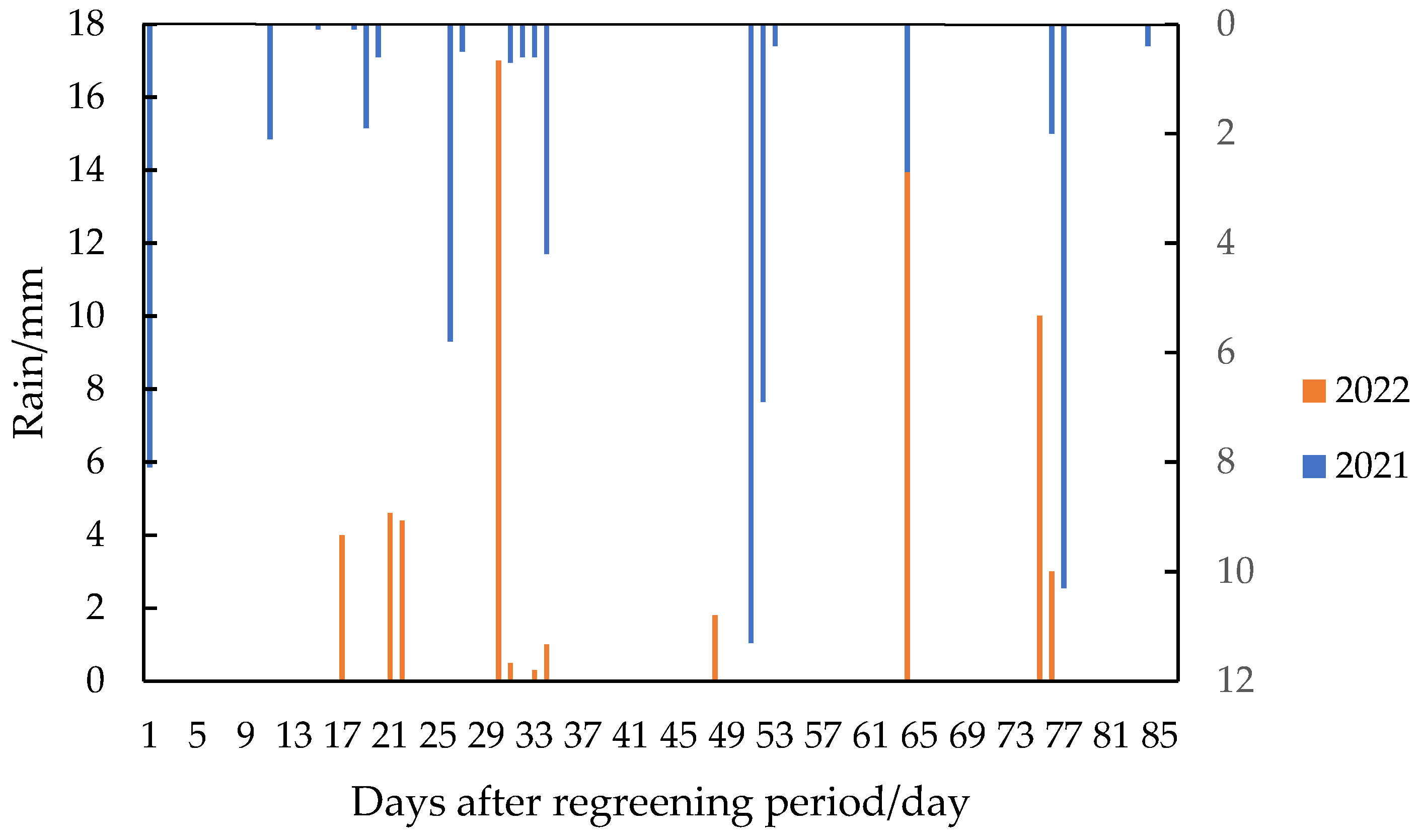
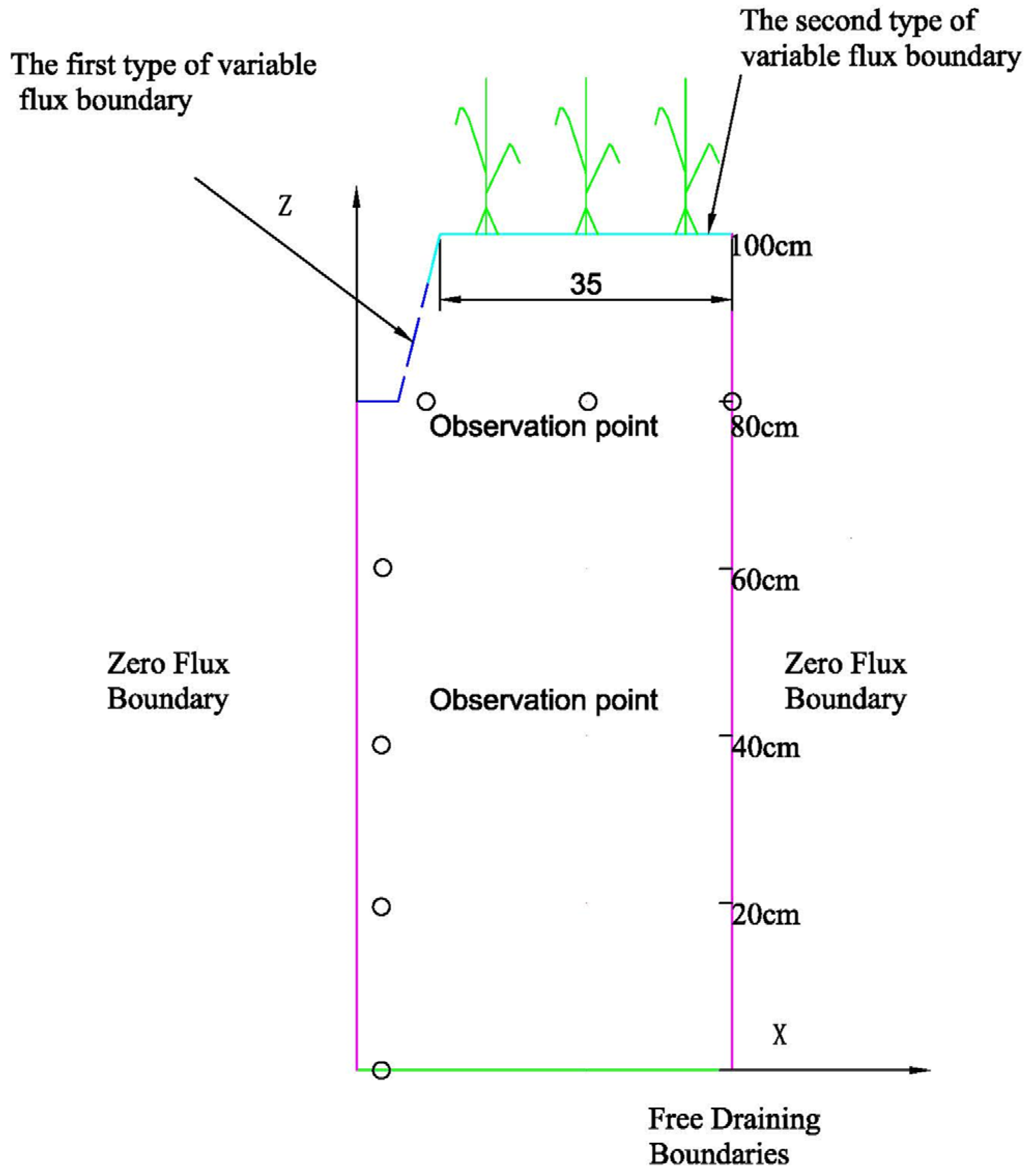

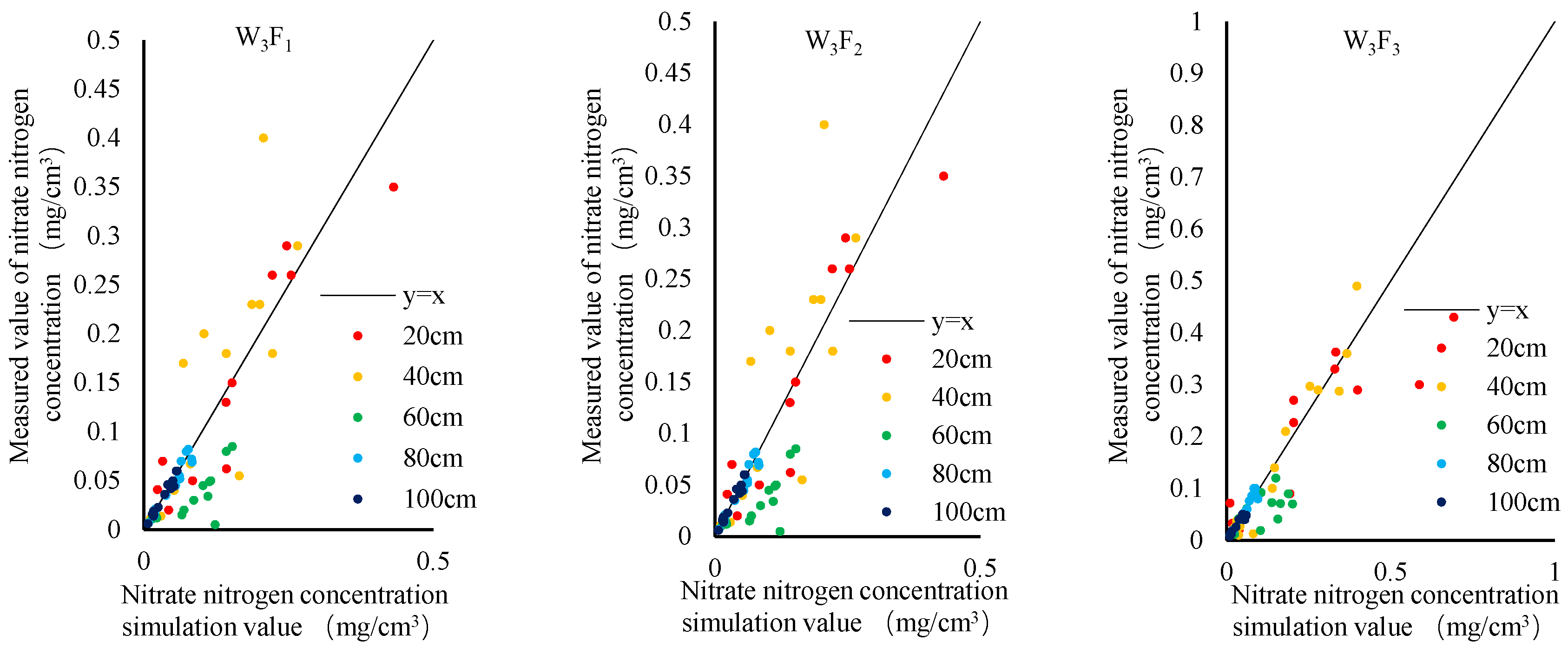
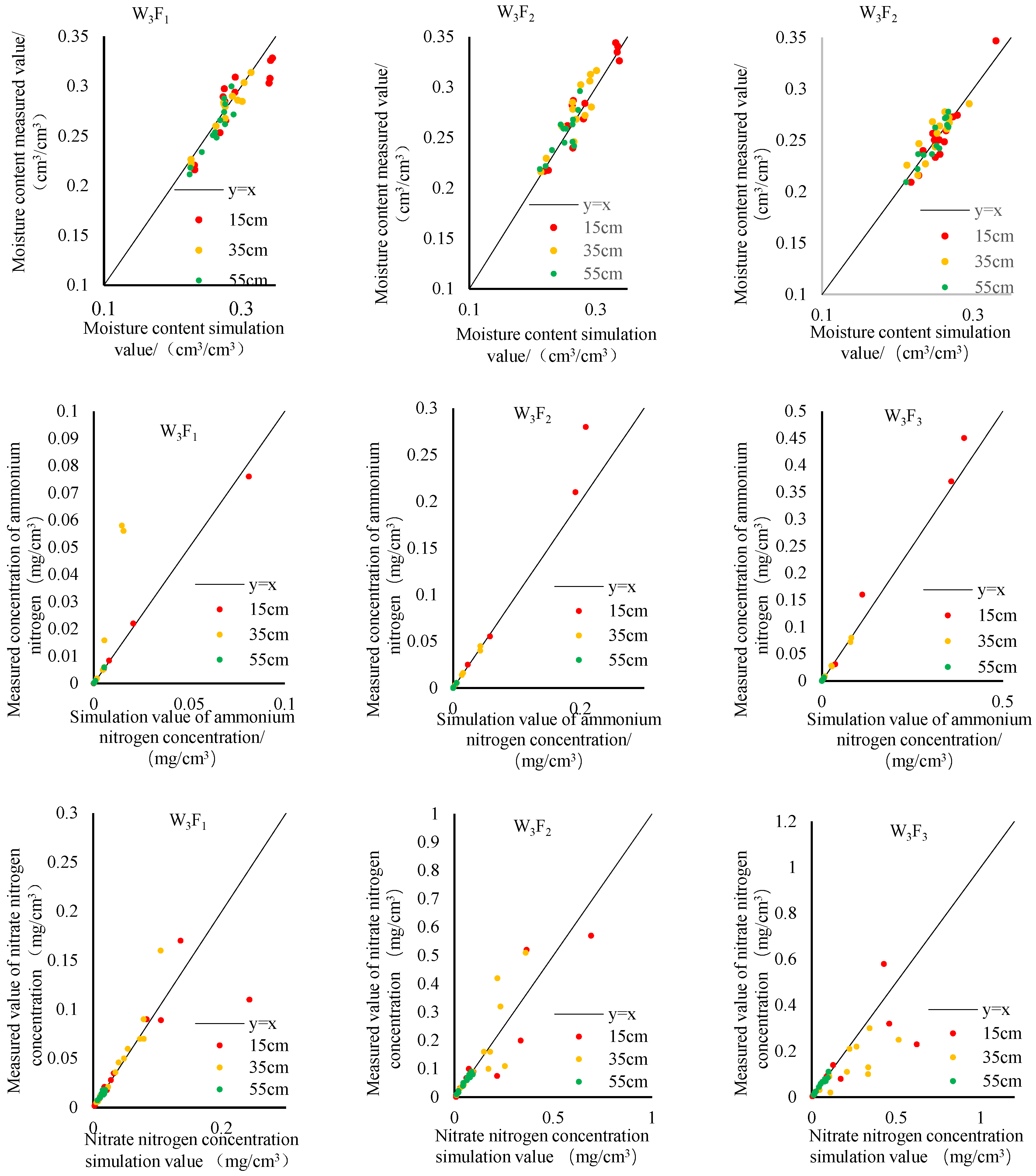
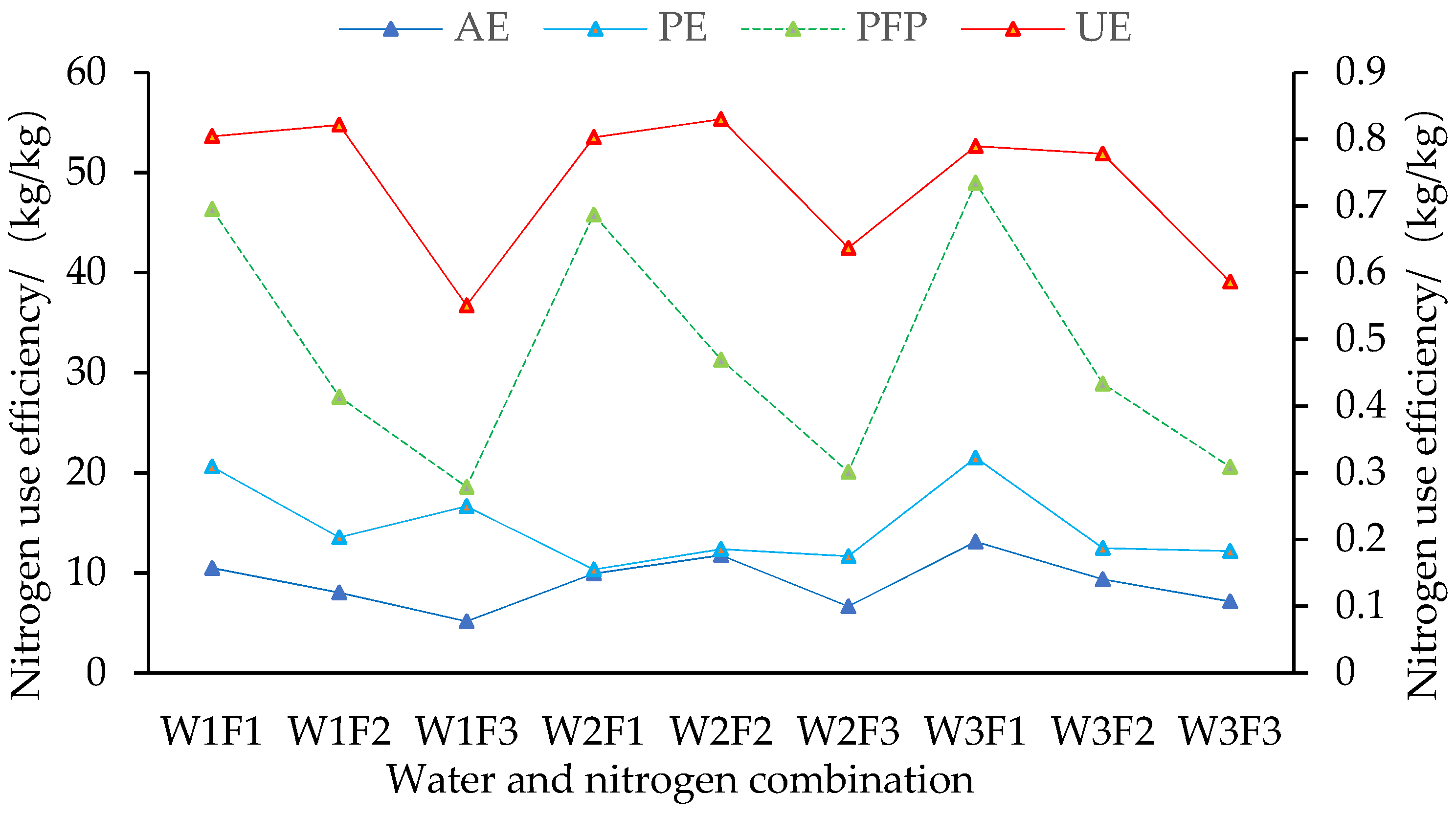
| Soil Depth (cm) | Soil Type | Soil Characteristic Parameters | Particle Size Composition (%) | Physicochemical Parameters of the Tested Soil | ||||||
|---|---|---|---|---|---|---|---|---|---|---|
| Dry Bulk Density of Soil (g/cm3) | Field Capacity (%) | Soil Organic Matter (%) | Average Total Nitrogen Content (%) | <0.002 | 0.002–0.02 | 0.02–2 | Ammonium Nitrogen (mg/kg) | Nitrate Nitrogen (mg/kg) | ||
| 0–20 | Loam | 1.45 | 34 | 0.87 | 0.05 | 7 | 43 | 53 | 9.48 | 8.62 |
| 20–40 | Silty loam | 1.47 | 32 | 0.86 | 0.05 | 7 | 44 | 49 | 8.24 | 4.67 |
| 40–60 | Silty loam | 1.48 | 30 | 0.83 | 0.04 | 6 | 45 | 49 | 11.65 | 6.05 |
| 60–80 | Silty loam | 1.5 | 29 | 0.78 | 0.04 | 6 | 43 | 51 | 7.74 | 4.81 |
| 80–100 | Silty loam | 1.46 | 28 | 0.56 | 0.03 | 2 | 12 | 86 | 9.57 | 8.18 |
| Treatment | Irrigation Lower Limit | Irrigation Water (mm) | Number of Top Dressing Applications | Nitrogen Application Rate (kg/ha) | |||
|---|---|---|---|---|---|---|---|
| Ground Fertilizer | Jointing Stage | Date of Ear Emergence | Grand Total | ||||
| W1F1 | 60% θfield | 90 | 2 | 55 | 32.5 | 32.5 | 120 |
| W1F2 | 82.5 | 82.5 | 220 | ||||
| W1F3 | 132.5 | 132.5 | 320 | ||||
| W2F1 | 70% θfield | 180 | 32.5 | 32.5 | 120 | ||
| W2F2 | 82.5 | 82.5 | 220 | ||||
| W2F3 | 132.5 | 132.5 | 320 | ||||
| W3F1 | 80% θfield | 240 | 32.5 | 32.5 | 120 | ||
| W3F2 | 82.5 | 82.5 | 220 | ||||
| W3F3 | 132.5 | 132.5 | 320 | ||||
| Parameter Name | P0 (cm) | P0Pt (cm) | P2H (cm/day) | P2L (cm) | P3 (cm) | r2h (cm/day) | r2L (cm/day) |
|---|---|---|---|---|---|---|---|
| Numerical value | 0 | −1 | −500 | −900 | −16,000 | 0.5 | 0.1 |
| θr (cm3/cm3) | θs (cm3/cm3) | α (cm−1) | n | Ks (cm/day) | R2 | |||
|---|---|---|---|---|---|---|---|---|
| Initial value | Treatment | Soil depth | 0.0324 | 0.3785 | 0.0253 | 1.4793 | 33.2 | 0.92 |
| 0.3815 | 0.0246 | 1.4376 | 25.3 | 0.98 | ||||
| 0.3927 | 0.0231 | 1.4563 | 29.4 | 0.97 | ||||
| 0.3721 | 0.0158 | 1.5239 | 36.6 | 0.94 | ||||
| 0.3865 | 0.0193 | 1.6271 | 25.4 | 0.93 | ||||
| Optimized value | W2F1 | 0–20 | – | 0.3785 | 0.0153 | 1.3293 | 36.2 | 0.95 |
| 20–40 | 0.3815 | 0.0146 | 1.2376 | 26.6 | 0.93 | |||
| 40–60 | 0.3927 | 0.0151 | 1.4563 | 30.7 | 0.94 | |||
| 60–80 | 0.3721 | 0.0158 | 1.3239 | 35.4 | 0.92 | |||
| 80–100 | 0.3865 | 0.0163 | 1.2271 | 24.6 | 0.9 | |||
| W2F2 | 0–20 | – | 0.3832 | 0.0143 | 1.3531 | 37.7 | 0.94 | |
| 20–40 | 0.3895 | 0.0134 | 1.2786 | 29.8 | 0.92 | |||
| 40–60 | 0.4032 | 0.0139 | 1.4957 | 32.1 | 0.91 | |||
| 60–80 | 0.3837 | 0.0147 | 1.3854 | 33.9 | 0.9 | |||
| 80–100 | 0.3843 | 0.0139 | 1.1295 | 23.2 | 0.9 | |||
| W2F3 | 0–20 | – | 0.3891 | 0.0135 | 1.3835 | 39.7 | 0.92 | |
| 20–40 | 0.3937 | 0.0127 | 1.3145 | 31.5 | 0.93 | |||
| 40–60 | 0.4154 | 0.0131 | 1.5054 | 33.8 | 0.93 | |||
| 60–80 | 0.3774 | 0.0149 | 1.3067 | 29.4 | 0.89 | |||
| 80–100 | 0.3835 | 0.0158 | 1.2174 | 31.8 | 0.91 |
| Treatment | Soil Depth (cm) | DL (cm) | (/day) | Kd (cm3/mg) | (/day) | (/day) | (/day) | (/day) | (/day) | (mg/cm3/day) | (mg/cm3/day) | ||
|---|---|---|---|---|---|---|---|---|---|---|---|---|---|
| Initial value | – | 20 | 10 | 0.56 | 0.0032 | 0.02 | 0.2 | 0.2 | 0.04 | 0.04 | 3 × 10−5 | 3 × 10−5 | |
| 40 | 10 | 0.55 | 0.0035 | 0.025 | 0.3 | 0.3 | 0.03 | 0.03 | 7 × 10−5 | 7 × 10−5 | |||
| 60 | 10 | 0.54 | 0.0035 | 0.03 | 0.26 | 0.26 | 0.03 | 0.03 | 5 × 10−6 | 5 × 10−6 | |||
| 80 | 10 | 0.58 | 0.0032 | 0.028 | 0.27 | 0.27 | 0.04 | 0.04 | 4 × 10−6 | 4 × 10−6 | |||
| 100 | 10 | 0.57 | 0.0037 | 0.37 | 0.36 | 0.36 | 0.05 | 0.05 | 3 × 10−6 | 3 × 10−6 | |||
| Value ranges | – | 0–100 | – | 0.3–0.8 | 0.003–0.004 | 0.02–0.05 | 0.01–0.68 | 0.02–0.72 | 0.01–0.24 | 0.02–0.24 | 1 × 10−6–8 × 10−5 | 1 × 10−6–8 × 10−5 | |
| Optimized value | W2F1 | 0–20 | – | 0.47 | 0.0032 | 0.03 | 0.26 | 0.26 | 0.02 | 0.02 | 1 × 10−5 | 1 × 10−5 | |
| 20–40 | 0.43 | 0.0035 | 0.025 | 0.34 | 0.34 | 0.03 | 0.03 | 1 × 10−5 | 1 × 10−5 | ||||
| 40–60 | 0.49 | 0.0036 | 0.033 | 0.27 | 0.27 | 0.02 | 0.02 | 1 × 10−5 | 1 × 10−5 | ||||
| 60–80 | 0.48 | 0.0036 | 0.038 | 0.37 | 0.37 | 0.02 | 0.02 | 4 × 10−6 | 4 × 10−6 | ||||
| 80–100 | 0.47 | 0.0035 | 0.37 | 0.26 | 0.26 | 0.01 | 0.01 | 8 × 10−6 | 8 × 10−6 | ||||
| W2F2 | 0–20 | – | 0.56 | 0.0032 | 0.023 | 0.25 | 0.25 | 0.04 | 0.04 | 7 × 10−6 | 7 × 10−6 | ||
| 2–40 | 0.55 | 0.0035 | 0.027 | 0.33 | 0.33 | 0.05 | 0.05 | 6 × 10−6 | 6 × 10−6 | ||||
| 40–60 | 0.54 | 0.0035 | 0.035 | 0.36 | 0.36 | 0.03 | 0.03 | 2 × 10−6 | 2 × 10−6 | ||||
| 60–80 | 0.58 | 0.0031 | 0.038 | 0.26 | 0.26 | 0.01 | 0.01 | 1 × 10−6 | 1 × 10−6 | ||||
| 80–100 | 0.57 | 0.0032 | 0.033 | 0.31 | 0.31 | 0.01 | 0.01 | 2 × 10−6 | 2 × 10−6 | ||||
| W2F3 | 0–20 | – | 0.58 | 0.0032 | 0.026 | 0.24 | 0.24 | 0.05 | 0.05 | 3 × 10−6 | 3 × 10−6 | ||
| 20–40 | 0.60 | 0.0035 | 0.029 | 0.32 | 0.32 | 0.07 | 0.07 | 2 × 10−6 | 2 × 10−6 | ||||
| 40–60 | 0.62/ | 0.0033 | 0.031 | 0.3 | 0.3 | 0.04 | 0.04 | 1 × 10−6 | 1 × 10−6 | ||||
| 60–80 | 0.58 | 0.0032 | 0.029 | 0.28 | 0.28 | 0.02 | 0.02 | 1 × 10−5 | 1 × 10−6 | ||||
| 80–100 | 0.57 | 0.0037 | 0.034 | 0.34 | 0.34 | 0.03 | 0.03 | 1 × 10−6 | 1 × 10−6 | ||||
| Direction | Treatment | Classification | MAE | RMSE | R2 |
|---|---|---|---|---|---|
| Perpendicular | W3F1 | Moisture content | 0.007 | 0.007 | 0.811 |
| Ammonium nitrogen | 0.003 | 0.003 | 0.7084 | ||
| Nitrate nitrogen | 0.011 | 0.012 | 0.7577 | ||
| W3F2 | Moisture content | 0.01 | 0.009 | 0.8147 | |
| Ammonium nitrogen | 0.007 | 0.009 | 0.7245 | ||
| Nitrate nitrogen | 0.051 | 0.054 | 0.744 | ||
| W3F3 | Moisture content | 0.006 | 0.005 | 0.8377 | |
| Ammonium nitrogen | 0.008 | 0.023 | 0.6818 | ||
| Nitrate nitrogen | 0.052 | 0.064 | 0.7718 | ||
| Level | W3F1 | Moisture content | 0.011 | 0.0106 | 0.832 |
| Ammonium nitrogen | 0.007 | 0.025 | 0.6918 | ||
| Nitrate nitrogen | 0.008 | 0.018 | 0.7353 | ||
| W3F2 | Moisture content | 0.012 | 0.011 | 0.8681 | |
| Ammonium nitrogen | 0.009 | 0.034 | 0.7125 | ||
| Nitrate nitrogen | 0.035 | 0.052 | 0.7871 | ||
| W3F3 | Moisture content | 0.008 | 0.008 | 0.8377 | |
| Ammonium nitrogen | 0.021 | 0.049 | 0.6889 | ||
| Nitrate nitrogen | 0.06 | 0.097 | 0.7844 |
| Water–Fertilizer Treatment | W1F1 | W1F2 | W1F3 | W2F1 | W2F2 | W2F3 | W3F1 | W3F2 | W3F3 |
|---|---|---|---|---|---|---|---|---|---|
| Ammonium nitrogen (kg/ha) | |||||||||
| Nitrogen application rate | 65.00 | 165.00 | 265.00 | 65.00 | 165.00 | 265.00 | 65.00 | 165.00 | 265.00 |
| Urea nitrogen hydrolysis | 43.03 | 114.62 | 209.63 | 38.62 | 124.72 | 208.35 | 42.74 | 112.09 | 207.59 |
| Mineralization reaction and biological fixation | 59.49 | 46.27 | 13.22 | 69.41 | 62.64 | 33.05 | 66.10 | 46.27 | 33.05 |
| Ammonia volatilization | 0.83 | 3.05 | 5.57 | 0.86 | 2.77 | 6.39 | 0.93 | 2.87 | 6.28 |
| Nitration | 89.75 | 134.31 | 188.81 | 93.25 | 163.96 | 217.10 | 100.78 | 136.78 | 213.97 |
| Root absorption amount | 8.91 | 17.70 | 15.09 | 10.84 | 13.65 | 17.59 | 6.78 | 16.22 | 14.01 |
| Soil accumulation | 3.03 | 5.82 | 13.38 | 3.07 | 6.99 | 0.33 | 0.34 | 2.49 | 6.38 |
| Nitrate nitrogen (kg/ha) | |||||||||
| Denitrification reaction | 6.33 | 15.61 | 63.20 | 7.69 | 20.40 | 75.14 | 7.07 | 26.26 | 81.74 |
| Root absorption amount | 81.59 | 118.58 | 107.67 | 83.93 | 141.88 | 136.22 | 92.59 | 107.02 | 127.07 |
| Soil accumulation | 1.83 | 0.13 | 17.94 | 1.64 | 1.67 | 5.74 | 1.12 | 3.50 | 5.16 |
| Total nitrogen uptake | 90.50 | 136.28 | 122.76 | 94.76 | 155.53 | 153.80 | 99.37 | 123.25 | 141.08 |
| Total nitrogen (g/ha) | 56.2 | 101.24 | 78.62 | 66.93 | 145.09 | 128.59 | 65.44 | 116.8 | 126.31 |
| Yield (kg/ha) | 5860.67 | 6070.33 | 5953.00 | 6121.33 | 6888.67 | 6431.00 | 5876.67 | 6361.33 | 6590.00 |
Disclaimer/Publisher’s Note: The statements, opinions and data contained in all publications are solely those of the individual author(s) and contributor(s) and not of MDPI and/or the editor(s). MDPI and/or the editor(s) disclaim responsibility for any injury to people or property resulting from any ideas, methods, instructions or products referred to in the content. |
© 2023 by the authors. Licensee MDPI, Basel, Switzerland. This article is an open access article distributed under the terms and conditions of the Creative Commons Attribution (CC BY) license (https://creativecommons.org/licenses/by/4.0/).
Share and Cite
Wang, S.; Liu, T.; Yang, J.; Wu, C.; Zhang, H. Simulation Effect of Water and Nitrogen Transport under Wide Ridge and Furrow Irrigation in Winter Wheat Using HYDRUS-2D. Agronomy 2023, 13, 457. https://doi.org/10.3390/agronomy13020457
Wang S, Liu T, Yang J, Wu C, Zhang H. Simulation Effect of Water and Nitrogen Transport under Wide Ridge and Furrow Irrigation in Winter Wheat Using HYDRUS-2D. Agronomy. 2023; 13(2):457. https://doi.org/10.3390/agronomy13020457
Chicago/Turabian StyleWang, Shunsheng, Tengfei Liu, Jinyue Yang, Chuang Wu, and Hao Zhang. 2023. "Simulation Effect of Water and Nitrogen Transport under Wide Ridge and Furrow Irrigation in Winter Wheat Using HYDRUS-2D" Agronomy 13, no. 2: 457. https://doi.org/10.3390/agronomy13020457




